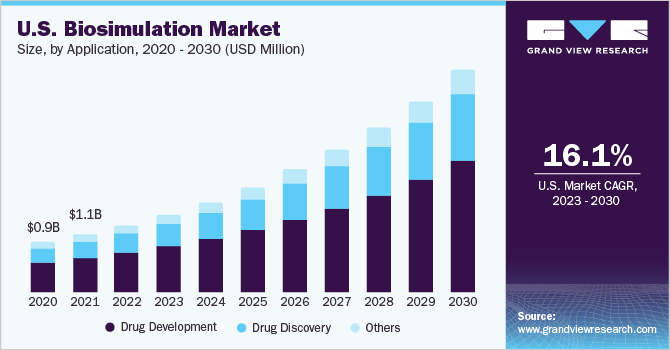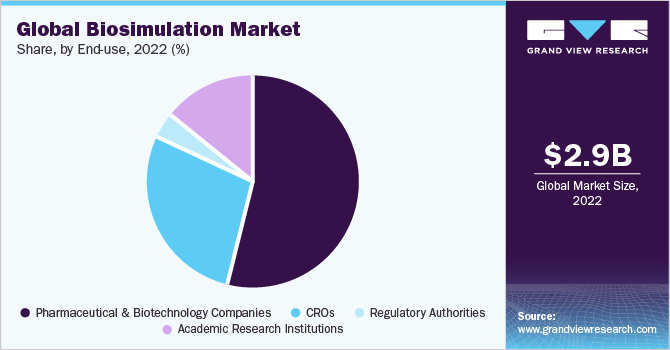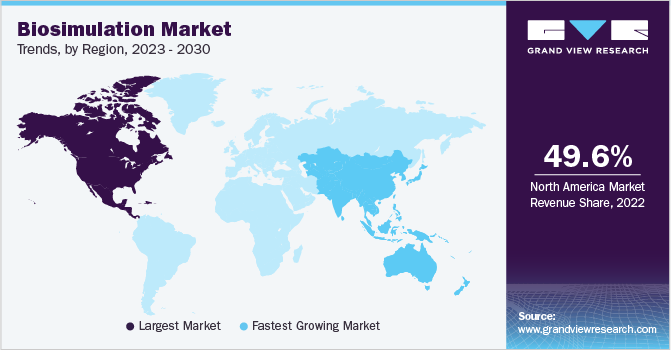- Home
- »
- Healthcare IT
- »
-
Biosimulation Market Size, Share & Trends Report, 2030GVR Report cover
![Biosimulation Market Size, Share & Trends Report]()
Biosimulation Market Size, Share & Trends Analysis Report By Product (Software, Services), By Application (Drug Development, Drug Discovery), By End Use, By Region, And Segment Forecasts, 2023 - 2030
- Report ID: GVR-1-68038-051-4
- Number of Pages: 170
- Format: Electronic (PDF)
- Historical Range: 2017 - 2020
- Industry: Healthcare
Report Overview
The global biosimulation market size was valued at USD 2.9 billion in 2022 and is expected to expand at a compound annual growth rate (CAGR) of 16.9% from 2023 to 2030. The rising incidence of drug relapse cases due to drug resistance in diseases including cancer, tuberculosis, and other bacterial infections is among the key trends stimulating the market growth. This is estimated to drive clinical urgency to incorporate biosimulation in the initial development of a new generation of drugs. The COVID-19 pandemic significantly impacted the healthcare industry including the biosimulation market. The need to rapidly test and develop COVID-19 vaccine candidates catalyzed the demand for biosimulation software and services. According to an April 2021 study published in the National Center for Biotechnology Information, known preclinical in vitro and in vivo datasets were used to conduct in silico modeling using a biosimulation solution - BIOiSIM. The purpose of the study was to accelerate the repurposing and drug development of Therapies used for Pulmonary Hypertension against COVID-19. The surge in similar studies indicated a positive impact on the market growth driven by the rising demand for accelerated drug development for COVID-19.

For instance, in August 2020, Certara, a key market player, collaborated with several pharmaceutical companies. This collaboration was intended to support the development of a new biosimulation tool to make it easier for developing vaccine candidates across multiple types of patient populations by using virtual patients and trials. It was also intended to provide insights before conducting any real-life studies. This new module was a part of the company’s Quantitative Systems Pharmacology (QSP) platform. In July 2020, the company also introduced the COVID-19 clinical outcomes database for providing updated information on COVID-19 clinical trial results and observational studies, globally.
Moreover, clinical urgency to develop high potency and advanced drugs is projected to play a pivotal role in the growth of the market. Biosimulation is being increasingly adopted in the simulation modeling of diseases such as diabetes mellitus. It is used in conjunction with proteomic and genomic technologies to develop models for advanced therapeutics.
Technological innovations and periodic up-gradation in the software are anticipated to boost the inclination of researchers towards biosimulation. This is likely to provide a significant push to the market. These technological advancements include the adoption of microarrays and predictive models. Other advancements include semantic technologies that support a finite number of elements of biosimulation, which reduces the time, cost, and complexity of the overall process.
The post-COVID era is introducing multiple innovative ideas in virtual and digital health processes. The wide application of biosimulation, decentralized trials, and in silico models during the pandemic has led to effective and fast drug developmental processes in the future. The global emergence of machine learning algorithms and AI has been advantageous for future research and development processes. A wide range of in silico online tools and biosimulation software that were once launched for designing peptide vaccines for COVID-19 are now being applied for therapeutic applications for other chronic diseases. Since the pandemic, bioinformatics experts have started using various biosimulation platforms, such as Universal Immune System Simulator, which is an effective way to discover pipeline products. These tools have improved therapeutic design and unveiled a better future in the dynamics of healthcare.
Product Insights
The software segment dominated the market in 2022 with a revenue share of over 68.7%. This is owing to the numerous application-specific software available in the market that caters to specific research and development requirements. For instance, Rhenovia Pharma provides software that specializes in the simulation of the mechanism of CNS-specific drugs. The product segment consists of software and services.
The services segment is poised to register the highest CAGR of 17.4 during the forecast period. The growth of the segment can be attributed to increasingly complex and multi-layered drug development systems, in which biosimulation services may prove to be imperative. The aforementioned is expected to be achieved through the formulation of new combination therapies that are more precise.
Key players are involved in providing an extensive array of services, which simplify the overall drug discovery and development processes. In February 2016, Certara launched Phoenix Technology Services, a range of biosimulation services employed to optimize R&D productivity, facilitate data transfer, and develop regulatory submission protocols.
Application Insights
Drug development held the largest revenue share of over 59.7% in 2022. A rising number of government initiatives promoting the incorporation of advanced software is contributing to the growth of the segment. For instance, the FDA’s critical path initiative report highlights the importance of this approach for drug development and suggests that it can be incorporated as an efficient predictive tool. The application segment includes drug development, drug discovery, and others.
Drug discovery is anticipated to register the highest CAGR of 17.3% throughout the forecast period. The growing adoption of biosimulation in areas such as pharmacogenomics and pharmacogenetics is supplementing the growth of the segment. In February 2020, Certara acquired modeling and simulation technology platform developed for the study of neurodegenerative conditions from In Silico Biosciences, Inc. This aided the company’s quantitative systems pharmacology (QSP) business model in its research focused on neurodegenerative diseases.
End-use Insights
Pharmaceutical and biotechnology companies accounted for a revenue share of more than 54.0% in 2022. The strong demand for biosimulation in these companies can be attributed to the constant efforts of key companies to prolong the lifecycles of off-patent drugs and discover drug variants by adopting a computer modeling approach. The end-use segment comprises pharmaceutical and biotechnology companies, CROs, regulatory authorities, and academic research institutions.

The CROs segment is estimated to grow at the fastest rate with a CAGR of 18.1% during the forecast period. The rising inclination of companies to reduce the overall expenditure is projected to escalate the growth of the segment. Other drivers include enhanced productivity and flexibility to focus on core areas of development, which are critical to the growth of a company.
Regional Insights
North America held the dominant revenue share of over 49.6% in 2022. This growth is attributed to the presence of key players, increasing digitization in healthcare, and the rising prevalence of chronic health issues. Moreover, the adoption of in-silico models during the enforcement of regulatory policies to ensure high patient safety and treatment standards is further contributing to the regional market growth.

The Asia Pacific is likely to witness exponential growth with a CAGR of 18.4% during the forecast period owing to rising initiatives by the public and private sector and consistent up-gradation in healthcare infrastructure. In addition, burgeoning R&D activities in emerging economies are poised to present the region with significant growth opportunities. In November 2020, Certara opened a new office in Shanghai, China. This enabled the company to strengthen its tie-up with customers in the rapidly growing Chinese biopharmaceutical market.
Key Companies & Market Share Insights
Key players deployed competitive sustainability strategies that include product development and geographical presence expansion to gain a greater market share. Market leaders are also highly inclined toward addressing unmet needs and delivering economic value through consistent product upgrades. For instance, in January 2022, Simulation Plus partnered with a pharmaceutical company for modifying the GastroPlus Advanced Compartmental Absorption and Transit (ACAT) model in support of the ongoing research programs for the treatment of gastrointestinal diseases. In December 2021, the U.S. FDA renewed and expanded its licenses of Certara’s proprietary biosimulation software, along with over 400 licenses of Phoenix and Simcyp software. Some prominent players in the global biosimulation market include:
-
Certara, USA
-
Dassault Systemes
-
Advanced Chemistry Development
-
Simulation Plus
-
Schrodinger, Inc.
-
Chemical Computing Group ULC
-
Physiomics Plc
-
Rosa & Co. LLC
-
BioSimulation Consulting Inc.
-
Genedata AG
-
Instem Group of Companies
-
PPD, Inc.
-
Yokogawa Insilico Biotechnology GmbH
-
Immunetrics
Biosimulation Market Report Scope
Report Attribute
Details
The market size value in 2023
USD 3.3 billion The revenue forecast in 2030
USD 10.0 billion
Growth rate
CAGR of 16.9% from 2023 to 2030
Base year for estimation
2022
Historical data
2017 - 2021
Forecast period
2023 - 2030
Quantitative units
Revenue in USD million/billion & CAGR from 2023 to 2030
Report coverage
Revenue forecast, company ranking, competitive landscape, growth factors, and trends
Segments covered
Product, application, end-use, region
Regions covered
North America; Europe; Asia Pacific; Latin America; MEA
Country Scope
U.S.; Canada; UK; Germany; France; Italy; Spain; Norway; Denmark; Swden; Japan; China; India; Australia; South Korea; Thailand; Brazil; Mexico; Argentina; South Africa; Saudi Arabia; UAE; Kuwait
Key companies profiled
Certara, USA; Dassault Systemes; Advanced Chemistry Development; Simulation Plus; Schrodinger, Inc.; Chemical Computing Group ULC; Physiomics Plc; Rosa & Co. LLC; BioSimulation Consulting Inc.; Genedata AG; Instem Group of Companies; PPD, Inc.; Yokogawa Insilico Biotechnology GmbH; Immunetrics
Customization scope
Free report customization (equivalent to up to 8 analysts’ working days) with purchase. Addition or alteration to country, regional & segment scope.
Pricing and purchase options
Avail of customized purchase options to meet your exact research needs. Explore purchase options
Segments Covered in the Report
This report forecasts revenue growth at the global, regional, and country levels and provides an analysis of the latest industry trends and opportunities in each of the sub-segments from 2017 to 2030. For this report, Grand View Research has segmented the global biosimulation market report based on product, application, end-use, and region:
-
Product Outlook (Revenue, USD Million, 2017 - 2030)
-
Software
-
Services
-
In-house Services
-
Contract Services
-
-
-
Application Outlook (Revenue, USD Million, 2017 - 2030)
-
Drug Development
-
Drug Discovery
-
Others
-
-
By Delivery Model (Revenue, USD Million, 2017 - 2030)
-
Subscription Models
-
Ownership Models
-
-
End-use Outlook (Revenue, USD Million, 2017 - 2030)
-
Pharmaceutical & Biotechnology Companies
-
CROs
-
Regulatory Authorities
-
Academic Research Institutions
-
-
Regional Outlook (Revenue, USD Million, 2017 - 2030)
-
North America
-
U.S.
-
Canada
-
-
Europe
-
UK
-
Germany
-
France
-
Italy
-
Spain
-
Norway
-
Denmark
-
Sweden
-
-
Asia Pacific
-
Japan
-
China
-
India
-
South Korea
-
Thailand
-
Australia
-
-
Latin America
-
Mexico
-
Brazil
-
Argentina
-
-
MEA
-
South Africa
-
Saudi Arabia
-
UAE
-
Kuwait
-
-
Frequently Asked Questions About This Report
b. The global biosimulation market size was estimated at USD 2.9 billion in 2022 and is expected to reach USD 3.3 billion in 2023.
b. The global biosimulation market is expected to grow at a compound annual growth rate of 16.9% from 2023 to 2030 to reach USD 10.0 billion by 2030.
b. North America dominated the biosimulation market with a share of 49.6% in 2022. This is attributable to the growing number of collaborations by key players for improving drug discovery capabilities and adopting in-silico models during enforcement of regulatory policies to ensure high patient safety & treatment standards.
b. Some key players operating in the biosimulation market include Dassault Systemes SA; Certara USA, Inc.; Advanced Chemistry Development, Inc.; Schrodinger, Inc.; Genedata AG; and Rhenovia Pharma Ltd.
b. Key factors that are driving the biosimulation market growth include increasing cases of drug relapse due to acquired drug resistance in diseases such as cancer, tuberculosis, and other bacterial infections, high clinical urgency to develop high potency and advanced drugs, and technological innovations and periodic up-gradation in the software.
Share this report with your colleague or friend.
![gvr icn]()
NEED A CUSTOM REPORT?
We can customize every report - free of charge - including purchasing stand-alone sections or country-level reports, as well as offer affordable discounts for start-ups & universities. Contact us now
![Certified Icon]()
We are GDPR and CCPA compliant! Your transaction & personal information is safe and secure. For more details, please read our privacy policy.
We are committed towards customer satisfaction, and quality service.
"The quality of research they have done for us has been excellent."





